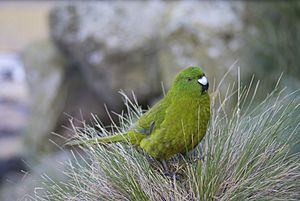Antipodes parakeet facts for kids
Quick facts for kids Antipodes parakeet |
|
|---|---|
 |
|
| A parakeet at Ringdove Bay on Antipodes Island. | |
| Conservation status | |
| Scientific classification | |
| Genus: |
Cyanoramphus
|
| Species: |
unicolor
|
The Antipodes parakeet (Cyanoramphus unicolor) is a special type of parrot. It lives only on the Antipodes Islands in New Zealand. This makes it an "endemic" species, meaning it's found nowhere else!
These parakeets are quite rare. They are one of only two parrot species on the Antipodes Islands. What's even more amazing is that they are one of only five parrots in the world that mostly live on the ground.
Antipodes parakeets can live for a long time, sometimes up to 10 years. However, tiny mice have been brought to the islands. These mice compete with the parakeets for food, which is a big problem for their survival.
These parrots are also unusual because they sometimes hunt and eat other birds. Another New Zealand parrot, the kea, shares this interesting habit.
Contents
What is an Antipodes Parakeet?
The Antipodes parakeet was first drawn in 1831 by an English artist named Edward Lear. He included it in his book called Illustrations of the Family of Psittacidae, or Parrots.
Lear first called it the "Uniform parakeet." He also gave it the scientific name Platycercus unicolor. Today, scientists place this bird in the Cyanoramphus group of parrots. This group was named in 1854 by a French bird expert, Charles Lucien Bonaparte.
The closest relative to the Antipodes parakeet is Reischek's parakeet. This parrot also lives on the Antipodes Islands. Other relatives include the Norfolk parakeet and the Chatham parakeet.
How to Spot One
The Antipodes parakeet is the biggest parrot in its group. It can grow to be about 30 centimeters (12 inches) long.
You might hear them before you see them! They make a loud and clear "kok-kok-kok-kok" sound.

Where They Live
The Antipodes parakeet lives only on the Antipodes Islands of New Zealand. They are quite common on the main Antipodes Island.
However, they are less common on smaller islands nearby. For example, you'll find fewer of them on Bollons Island. They live in very small numbers on Leeward Island and Archway Island too. On these smaller islands, they only live in tiny areas, about 0.1 square kilometers each.
What They Eat and Do
These parakeets have a varied diet. They eat leaves, buds, and different parts of grasses. Sometimes, they also munch on seeds and flowers.
They are also known to scavenge, meaning they will eat dead seabirds they find. In a unique behavior for parrots, they sometimes hunt grey-backed storm petrels. They can even dig into burrows to catch adult petrels.
Antipodes parakeets spend a lot of their time on the ground. They usually live in very small groups, in pairs, or sometimes by themselves.
They are known to be very curious birds. They can also be quite territorial and playful.
When it's time to nest, they dig a tunnel. Their nest is usually about 2 meters (6.5 feet) deep in the peaty soil. This helps protect their eggs and chicks from the wind.
Their Future
The number of Antipodes parakeets is currently stable. However, their conservation status is listed as "Vulnerable." This means they could be at risk in the future.
There are about 2,000 to 3,000 of these parakeets in the wild. While most live on the Antipodes Islands, a small group now lives on the New Zealand mainland. This group started with fewer than 20 birds.
See also
 In Spanish: Perico de Antípodas para niños
In Spanish: Perico de Antípodas para niños


